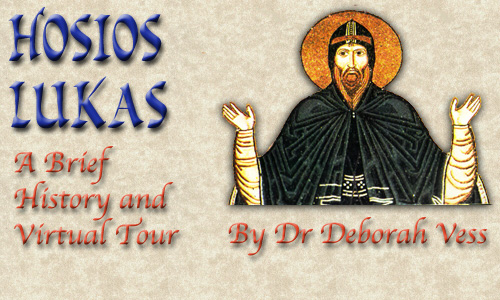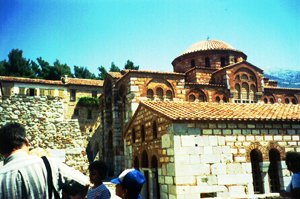 |
|
The monastery of Hosios Lukas was an important center of Greek Orthodox Christianity in the Byzantine period. It is located on Mount Helikonas, and was founded by Hosios Lukas, known as "the steriotes." During the Saracen invasions, his parents left the island of Aegina with his parents. His family temporarily settled in Fokida, near modern Mount Yannimakia. They later left Fokida and traveled to Kastorion, where Hosios Lukas was born in 896 C.E. At the age of fourteen, he traveled along with two monks to Attica. Hosios Lukas spent a great deal of time in solitude, and for thirty-five years until 917 C.E. lived in the church of Anargiros Saints in Yannimakia. From 917-927 he lived with other ascetics in Zemenons and Patras, and then returned to Yannimakia where he stayed until 939 C.E. From 939-942 he lived in Kalami, and then went to the island Ambelaki, on cape Zaltsa. In 945 he left the island and settled on a plain below the acropolis of the old Steirion, located on the site of the sanctuary of Demetra. There was a fountain on this location, and there he built his cell and garden. His fame as an ascetic started to spread, others came to join him, and so began the monastery of Hosios Lukas. One can still see the fountain in front of the church today. Hosios Lukas acquired a reputation for his ability to cure illness and disease, and his fame encouraged wealthy nobles to patronize the monastery. The donations which flowed in allowed the monks to built the first church there, which they consecrated to Saint Barbara; it is now consecrated to the Virgin Mary. Hosios Lukas also had the gift of prophecy, and predicted the Bulgarian invasion of Greece, the liberation of Crete, and his own death in 953. His death was first commemorated in 955 C.E., and his cult began to grow after the liberation of Crete in 961 fulfilled his prophecy. Since then, the monastery of Hosios Lukas has been a site of pilgrimage, as his tomb was associated with miracles. As the cult grew, the abbot Filoceos and his brethren Gabriel, Gregorius, and Petros built a second church to house the relics of Hosios Lukas. The present monastery contains the monks' cells, which are two or three stories high, and the bell tower, the Trapeza, and the two shrines with the crypt where the tomb of Hosios Lukas lies. The monastery is built on a slope, and so the monastery has five sides. Pictorial Tour of the Monastery
The crypt and tomb of Hosios Lukas View of the church of the Virgin and the church of Hosios Lukas Various views of the grounds of the monastery
To return to the medieval monasticim home page, click here. To return to the virtual tours page, click here. |
 This is the beginning
of the path from the visitors' center to to the church of Hosios Lukas.
You can explore more of the monastery through the links below.
This is the beginning
of the path from the visitors' center to to the church of Hosios Lukas.
You can explore more of the monastery through the links below. 